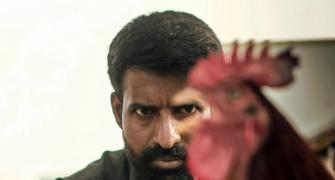The show takes its own pace to pick up, but then when you least expect, it grabs you by the throat, notes Aseem Chhabra.

'Does the world need another cinematic representation of the Ripley story?' That is the question I asked myself when the teaser, and then trailer, of the new Netflix series dropped a few months ago.
I answered the question myself: 'Yes, of course, we can definitely do with more Ripley on the screen, even when I know the story so well.'
I have been a fan of the films based on the character Tom Ripley, a conniving imposter, an insecure man and yet utterly charming, created by Patricia Highsmith in her five Ripley books also referred to as Ripliad, starting with The Talented Mr Ripley (1955), the source for the 1960 French film Purple Noon directed by Rene Clement (the restored version of the film was re-introduced to the world in 1996 by Martin Scorsese). The same book was also adapted by Anthony Minghella for his 1999 film, also called The Talented Mr Ripley.
The new Netflix series, written and directed by Steven Zaillian (Oscar winner for Schindler's List), is based on Highsmith's first book.
While I will admit I have not read Highsmith's books (her 1950 novel Strangers on a Train was adapted for the screen by Alfred Hitchcock), I have been engaged with the Ripley films for some time, including Ripley's Game (2002) starring John Malkovich. No spoiler here, but Malkovich makes a surprise appearance in Zaillian's Ripley.
There is also a Wim Wenders' take on Ripley's Game called The American Friend (1977), which is on my watch list. In last year's Saltburn, Barry Keoghan plays a Ripley-like character. Emerald Fennell's film is clearly inspired by the Ripley story, but it also takes many departures from Highsmith's narrative.

So I really waited for the Netflix show.
There were many reasons why I was looking forward it, one of which was that it stars Andrew Scott -- the 'hot priest' from Fleabag, who recently shattered our hearts into small pieces with his tragic performance in All of Us Strangers (a film criminally ignored by Oscar voters).
Zaillian's eight-part slow-burning, moody and at times riveting show, with stunning black and white cinematography stands on its own. But I could not help that the other versions of the Ripley story played in my mind at the same time.
In a 1971 short French documentary, Highsmith talked about seeing a man walk on the beach in Positano, Italy. The documentary is available on the Criterion Channel.
It was in the early 1950s, 6 am.
The man looked upset.
From that image of the man who Highsmith did not speak to, she created Ripley, her most famous fictional character who impersonates his friend, is an expert at forgery and even kills to survive in the world of the rich and the famous, where he is an outsider. In the same interview, Highsmith said she did not think Ripley was very likable.
But the Ripley in Zaillian's show, as well as in Purple Noon (a very handsome Alain Delon) and The Talented Mr Ripley (an equally handsome Matt Damon) are all very likable. That is why we care so much for the character. We want Ripley to survive even when he leaves a trail of crimes -- horrific murders and forged bank checks.

A part of it has to do with Ripley's insecurities and how he is taunted by his friend -- Richard Greenleaf, better known as Dickey, played by a charismatic Johnny Flynn in the current show. Flynn is good, but possibly overshadowed by Jude Law, who played a very sexually charged Greenleaf in Minghella's film, which also had the most gay subtext among all the representations of the story.
Ripley was sent to Italy to track Greenleaf by his wealthy shipbuilding father, played in the show, by a subdued, yet tough Kenneth Lonergan, better known as a playwright and director of films such as Manchester By The Sea.
Greenleaf Senior funded Ripley's trip to Italy. But when his son shows no signs of returning to the US, he decides to cut the flow of money and cancel the large sum he had promised Ripley upon completion of the job.
That is when Ripley's life, his plans and dreams start to fall apart.
In order to pick up the pieces and stand back on his feet, Ripley starts to commit crimes: Some that take place in the heat of passion, while others are meticulously planned and executed.
We watch Andrew Scott's Ripley struggle through the mess he has created, at times finding it hard to keep it straight in his head if he is Ripley or Greenleaf, while the police are trying to track the two down and solve the complex twists in the narrative.
He jumps hotels and moves from one Italian city to another.
The show at times becomes a tourism piece for Italy where the camera lovingly strolls along the beaches, streets, old historic parts and steps of several Italian cities including Rome, Naples, Palermo, Atrani, San Remo, even Venice.

The show takes its own pace to pick up, but then when you least expect, it grabs you by the throat.
There are some delightfully dark and creepy moments. An entire episode set in Rome is dedicated to Ripley trying to dispose of a body, as he drags it down a staircase (the elevator in the building keeps breaking down) leaving a trail of blood, that looks rather gooey in dark shades of black.
We also find a lot of beauty in Zaillian's show, especially in the performances of two of the principal cast members. Dakota Fanning plays Marge Sherwood, Dickie Greenleaf's love interest who quietly suffers as Ripley gets close to her boyfriend.
Zaillian made a very unique casting choice by casting Eliot Sumner (Sting and Trudie Styler's non-binary child) to play Dickie's wealthy friend Freddie Miles. Eliot has soft, gentle features which makes his Freddie quite menacing.
In Minghella's film, Philip Seymour Hoffman was cast as Freddie and he used his deep voice and physicality to scare Ripley, and make him nervous.
But the real star of the Netflix series is its stark black and white cinematography -- the work of master cameraman Robert Elswit (Oscar winner for There Will Be Blood).
Every shot, every frame is precious.
It is film noir at its best but inspired by classic films such as Citizen Kane (1941) and The Third Man (1949).
I wish I could have spent time taking screen shots of many of the scenes on my laptop but Netflix's copyright laws do not allow that. If a coffee table book is produced of the images from the show, I will be first in the line to buy it.
Ripley streams on Netflix.











